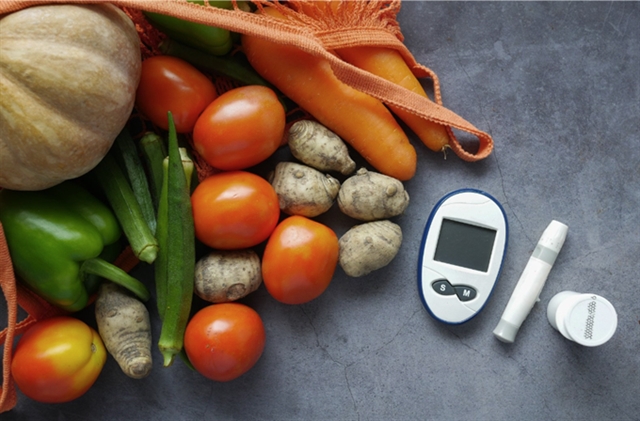
Don't let diabetes go unchecked, consult a doctor for a healthy future! Photo shutterstock.com
Dr. Trần Thị Thu Hương
As an endocrinologist, I see many cases of diabetes, a chronic disease characterised by high blood sugar levels. Around six per cent of the population in Việt Nam suffers from it and when left untreated it can lead to severe complications in the cardiovascular system, kidneys, nerves, eyes, feet and immune system.
The good news is that it is a quite manageable disease and lifestyle changes have a significant impact on the severity of the disease!
Let me give you two examples to illustrate this:
Mr Quang is a 50 years old taxi driver. During a health checkup for a work permit certificate, elevated glucose (=sugar) levels were detected in his blood, putting him in a prediabetes range. That means the sugar level is higher than normal, but still below the diabetes threshold. Studies show that up to 70 per cent of individuals with prediabetes will eventually develop type 2 diabetes. Worried about these prospects, Mr Quang asked what the best treatment would be.
Lifestyle changes are the first-line approach to diabetes prevention. A large study showed that participants in a Lifestyle Change Group decreased their risk of developing type 2 diabetes by 58 per cent compared to a placebo group and when they were followed up, even after 22 years, there was still a 25 per cent reduction in the risk of diabetes development. I explained to him about the diabetic plate method to create healthy meals and the glycemic index (GI) of food, which is a measure of how quickly different types of food can increase blood sugar. Changing what you eat can have a significant impact on blood sugar.
A first measure is to reduce portion size, in order to avoid overeating. And where possible, to avoid white rice, which can have a significant impact on blood sugar levels. There are alternatives like brown rice or quinoa, which have a lower glycemic index (GI) and provide more fibre. Make sure to include non-starchy vegetables in all meals like leafy greens, broccoli, cauliflower and bell peppers. Mr Quang understood that he needed to stay away from desserts and snacks, but was surprised when I explained that many drinks (soft drinks, fruit juices, flavoured coffee drinks and alcohol) contain a lot of sugar and should thus be avoided.
After making some changes, Mr Quang has been successfully managing his pre-diabetic condition.
Another example is Ms Huyen, a 44 year old accountant. She has had diabetes type 2 and unstable blood glucose levels for eight years. She did not have too many symptoms, so she did not care too much. She was prescribed some medicine, but she did not follow the prescribed dosage rigorously. After a few months, she started feeling very tired and thirsty. She had to urinate frequently and rapidly lost weight.
When she came to see me, her blood sugar levels were high and protein was detected in her urine, a sign of complications in the kidney. I explained that the damage from high blood sugar is gradual and can remain hidden for years. Evaluating her condition, I prescribed her insulin therapy. My nurse and I explained to her about the target levels for blood glucose and how to monitor those. We showed how to inject insulin and store it correctly. But also urged her to follow a diet and increase exercise to manage her blood sugar levels.
At the start of insulin treatment, it’s crucial to measure and record glucose levels daily. Patients then send me those readings via email so I can closely guide them and adapt medication and dosage when needed.
After three months of treatment, Ms. Huyền had recuperated, her condition was good and she had gained weight. The HbA1C (average glucose over three months) had improved and protein in urine had decreased. She felt happy and confident in managing her blood sugar.
These two cases are examples of the many diabetic patients who come to see me. What they have in common is that in the beginning they are afraid of diabetes. But once they understand they can influence their blood sugar levels by diet and exercise, or become competent in using insulin, they feel more secure. They say things like “Why didn’t I do this before” or “It wasn’t as hard as I thought it would be once I paid attention to my test results and got professional help”.
Remember that health care providers are there to help and assist you to overcome barriers and achieve your target blood glucose. Don’t ignore test results and proactively visit a doctor to get valuable advice and treatment!

Dr. Trần Thị Thu Hương. Photo courtesy of Family Medical Practice
* Dr. Trần Thị Thu Hương is our Internist and Endocrinologist. With 12 years of experience working in a public hospital, Dr. Hương brings a wealth of expertise to her field.
She holds a master's degree in Internal Medicine from Hà Nội Medical University in Việt Nam.
Additionally, she has completed a comprehensive continuing medical course focused on the diagnosis and treatment of Endocrine Disease and Diabetes.
Dr. Hương has also obtained a certificate in thyroid fine needle aspiration biopsy from Bạch Mai Hospital.
Further enhancing her knowledge, she has completed an Endocrinology and Metabolism course at Cathay General Hospital in Taipei, Taiwan.
She is fluent in English and Vietnamese.
OVietnam